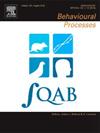Individual consistency of hissing displays across night and day in a free-living female songbird
IF 1.3
4区 生物学
Q4 BEHAVIORAL SCIENCES
引用次数: 0
Abstract
Birds have evolved a variety of antipredator strategies, which have been extensively studied during day-time. Yet, how diurnal birds directly respond to nocturnal predation threats remains largely elusive, despite that predation risk can be high during both night- and day-time. One form of antipredator behaviour found in several tit species when confronted with a predator at the nest is the hissing display. As for many forms of antipredator behaviour, studies on hissing displays have so far focussed on the day-time. Here, we exposed cavity-nesting free-living female great tits (Parus major) to simulated predator intrusions inside their nest box during both night- and day-time. We showed that 28 % of females uttered at least one hissing call during night-time, while the occurrence of hissing calls was higher during day-time (84 %). Hissing females at night, compared to non-hissing females, produced more hissing calls during day-time, providing evidence for individual cross-context consistency. Night-time hissing behaviour did not predict lay date, clutch size, breeding or nest success, indicating the absence of consequences in terms of current reproduction. Together, we reveal the hitherto undescribed occurrence of hissing displays at night in a cavity-nesting bird, while simultaneously strengthening the evidence for the existence of hissing behavioural types.
自由生活的雌性鸣鸟嘶鸣表演的昼夜个体一致性。
鸟类进化出了多种反捕食策略,这些策略在白天已被广泛研究。然而,昼行性鸟类如何直接应对夜间的捕食威胁在很大程度上仍然难以捉摸,尽管捕食风险在夜间和白天都很高。当山雀在巢中遇到捕食者时,它们的一种反捕食行为是发出嘶嘶声。与许多形式的反捕食行为一样,有关嘶嘶声表演的研究迄今为止都集中在白天。在这里,我们让穴巢自由生活的雌性大山雀(Parus major)在夜间和白天都在巢箱内模拟捕食者的入侵。结果表明,28%的雌性大山雀在夜间至少发出一次嘶嘶声鸣叫,而在白天嘶嘶声鸣叫的发生率更高(84%)。与不发出嘶嘶声的雌性相比,夜间发出嘶嘶声的雌性在白天发出的嘶嘶声叫声更多,这为个体的跨环境一致性提供了证据。夜间嘶嘶声行为并不能预测产卵日期、卵块大小、繁殖或筑巢成功率,这表明夜间嘶嘶声行为对当前的繁殖没有影响。总之,我们揭示了穴巢鸟夜间嘶叫行为的出现,这是迄今为止尚未发现的,同时也加强了嘶叫行为类型存在的证据。
本文章由计算机程序翻译,如有差异,请以英文原文为准。
求助全文
约1分钟内获得全文
求助全文
来源期刊

Behavioural Processes
生物-动物学
CiteScore
2.70
自引率
7.70%
发文量
144
审稿时长
4-8 weeks
期刊介绍:
Behavioural Processes is dedicated to the publication of high-quality original research on animal behaviour from any theoretical perspective. It welcomes contributions that consider animal behaviour from behavioural analytic, cognitive, ethological, ecological and evolutionary points of view. This list is not intended to be exhaustive, and papers that integrate theory and methodology across disciplines are particularly welcome.
 求助内容:
求助内容: 应助结果提醒方式:
应助结果提醒方式:


